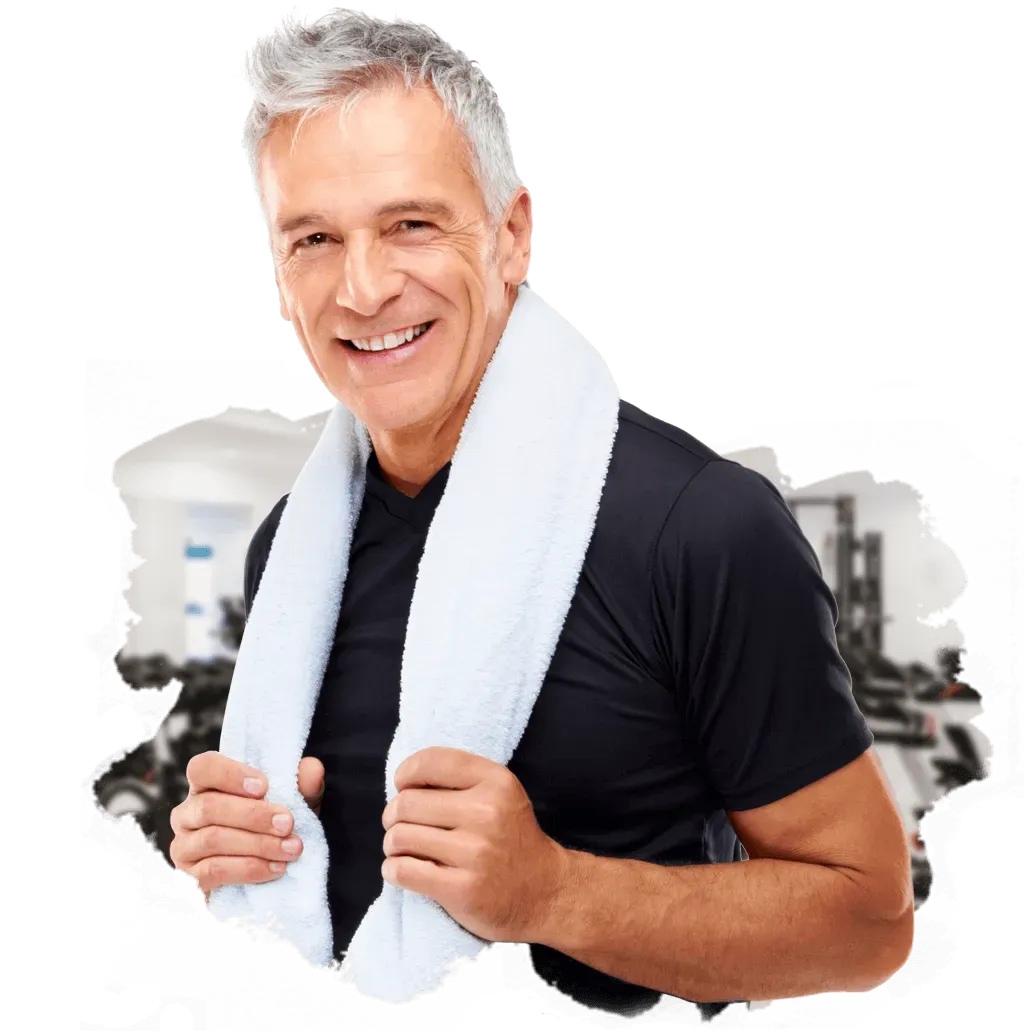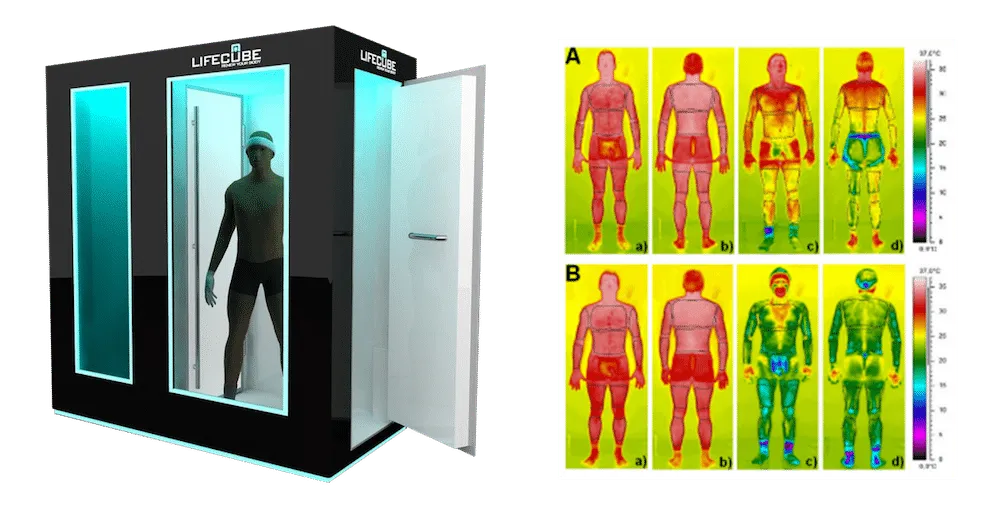Cryotherapy Cincinnati
Optimize Your Body With a Touch of Ice
CLICK BELOW TO WATCH FIRST!
Cryotherapy Cincinnati
Optimize Your Body With a Touch of Ice
CLICK BELOW TO WATCH FIRST!
What is Cryotherapy?
Science-backed therapies like cryotherapy, also known as cold therapy, are non-invasive treatments that involve exposure to extremely low temperatures to promote physical and mental well-being. The therapy is based on the principle that cold temperatures can stimulate the body’s natural healing processes, leading to a range of benefits including pain relief, reduced inflammation, and improved immune function. Cryotherapy can be administered in various forms, including whole body cryotherapy, localized cryotherapy, and cryotherapy chambers.
What is Cryotherapy?
Science-backed therapies like cryotherapy, also known as cold therapy, are non-invasive treatments that involve exposure to extremely low temperatures to promote physical and mental well-being. The therapy is based on the principle that cold temperatures can stimulate the body’s natural healing processes, leading to a range of benefits including pain relief, reduced inflammation, and improved immune function. Cryotherapy can be administered in various forms, including whole body cryotherapy, localized cryotherapy, and cryotherapy chambers.
How Cryotherapy Works
During a cryotherapy session, the body is exposed to extremely low temperatures, typically between -100°C to -150°C, for a short period of time, usually 2-3 minutes. The cold temperature causes the blood vessels to constrict, which helps to reduce inflammation and pain. As the body warms up after the session, the blood vessels dilate, and the increased blood flow helps to promote healing and reduce inflammation. Cryotherapy also stimulates the release of certain neurotransmitters, such as endorphins and dopamine, which can help to improve mood and reduce stress.
Cryotherapy can be a valuable tool for athletes and individuals looking to improve their physical performance. The therapy can help to reduce muscle soreness and inflammation, improve recovery time, and boost energy levels. Cryotherapy can also help to improve mental performance by reducing stress and anxiety, and improving focus and concentration. Many professional athletes and teams use cryotherapy as part of their training and recovery regimen. Additionally, red light therapy can be a complementary treatment, supporting skin rejuvenation, athletic performance enhancement, and overall well-being.

How Cryotherapy Works
During a cryotherapy session, the body is exposed to extremely low temperatures, typically between -100°C to -150°C, for a short period of time, usually 2-3 minutes. The cold temperature causes the blood vessels to constrict, which helps to reduce inflammation and pain. As the body warms up after the session, the blood vessels dilate, and the increased blood flow helps to promote healing and reduce inflammation. Cryotherapy also stimulates the release of certain neurotransmitters, such as endorphins and dopamine, which can help to improve mood and reduce stress.
Cryotherapy can be a valuable tool for athletes and individuals looking to improve their physical performance. The therapy can help to reduce muscle soreness and inflammation, improve recovery time, and boost energy levels. Cryotherapy can also help to improve mental performance by reducing stress and anxiety, and improving focus and concentration. Many professional athletes and teams use cryotherapy as part of their training and recovery regimen. Additionally, red light therapy can be a complementary treatment, supporting skin rejuvenation, athletic performance enhancement, and overall well-being.

Types of Cryotherapy
Cryotherapy, also known as cold therapy, offers a variety of methods to cater to different needs and preferences. Here are the main types
Whole Body Cryotherapy (WBC): This is the most popular form, where the entire body is exposed to extremely low temperatures in a cryotherapy chamber. This method is ideal for those looking to boost their immune system, enhance athletic performance, and achieve overall well-being.
Local Cryotherapy: Targeting specific areas such as the face, neck, or joints, local cryotherapy is perfect for addressing localized pain, inflammation, and skin rejuvenation.
Cryosurgery: A medical procedure that uses extremely low temperatures to destroy abnormal or damaged cells, often used in dermatology and oncology.
Cryostimulation: This type focuses on stimulating the body’s natural healing processes through cold temperatures, aiding in faster recovery and pain management.
Each type of cryotherapy offers unique benefits, making it a versatile option for various health and wellness goals.
What to Expect During a Cryotherapy Session
If you’re new to cryotherapy, knowing what to expect can help ease any apprehensions. Here’s a step-by-step guide:
Preparation: You’ll be asked to remove any jewelry, glasses, and clothing, and wear a robe, socks, and gloves to protect your skin.
Entering the Cryotherapy Chamber: You will be led to the cryotherapy chamber, where you will be exposed to extremely low temperatures, typically between -150°F and -200°F, for about 2-3 minutes.
During the Session: You might feel a slight stinging or burning sensation, but rest assured, this is temporary and harmless.
Post-Session: After the session, you may feel invigorated and refreshed. The increased blood circulation and reduced inflammation can leave you feeling rejuvenated and ready to tackle your day.
Understanding the process can make your first cryotherapy experience smooth and enjoyable.
Types of Cryotherapy
Cryotherapy, also known as cold therapy, offers a variety of methods to cater to different needs and preferences. Here are the main types
Whole Body Cryotherapy (WBC): This is the most popular form, where the entire body is exposed to extremely low temperatures in a cryotherapy chamber. This method is ideal for those looking to boost their immune system, enhance athletic performance, and achieve overall well-being.
Local Cryotherapy: Targeting specific areas such as the face, neck, or joints, local cryotherapy is perfect for addressing localized pain, inflammation, and skin rejuvenation.
Cryosurgery: A medical procedure that uses extremely low temperatures to destroy abnormal or damaged cells, often used in dermatology and oncology.
Cryostimulation: This type focuses on stimulating the body’s natural healing processes through cold temperatures, aiding in faster recovery and pain management.
Each type of cryotherapy offers unique benefits, making it a versatile option for various health and wellness goals.
What to Expect During a Cryotherapy Session
If you’re new to cryotherapy, knowing what to expect can help ease any apprehensions. Here’s a step-by-step guide:
Preparation: You’ll be asked to remove any jewelry, glasses, and clothing, and wear a robe, socks, and gloves to protect your skin.
Entering the Cryotherapy Chamber: You will be led to the cryotherapy chamber, where you will be exposed to extremely low temperatures, typically between -150°F and -200°F, for about 2-3 minutes.
During the Session: You might feel a slight stinging or burning sensation, but rest assured, this is temporary and harmless.
Post-Session: After the session, you may feel invigorated and refreshed. The increased blood circulation and reduced inflammation can leave you feeling rejuvenated and ready to tackle your day.
Understanding the process can make your first cryotherapy experience smooth and enjoyable.
Cryotherapy for Skin Health
Cryotherapy isn’t just for athletes; it offers remarkable benefits for skin health too:
Improved Collagen Production: Exposure to cold temperatures can stimulate collagen production, enhancing skin elasticity and reducing the appearance of fine lines and wrinkles.
Reduced Inflammation: Cryotherapy can significantly reduce inflammation, helping to improve skin conditions like acne and eczema.
Enhanced Skin Tone: Regular sessions can improve skin tone and reduce hyperpigmentation, giving you a more even and radiant complexion.
Incorporating cryotherapy into your skincare routine can lead to noticeable improvements in skin health and appearance.

Cryotherapy for Skin Health
Cryotherapy isn’t just for athletes; it offers remarkable benefits for skin health too:
Improved Collagen Production: Exposure to cold temperatures can stimulate collagen production, enhancing skin elasticity and reducing the appearance of fine lines and wrinkles.
Reduced Inflammation: Cryotherapy can significantly reduce inflammation, helping to improve skin conditions like acne and eczema.
Enhanced Skin Tone: Regular sessions can improve skin tone and reduce hyperpigmentation, giving you a more even and radiant complexion.
Incorporating cryotherapy into your skincare routine can lead to noticeable improvements in skin health and appearance.

Cryotherapy for Stress Relief
In today’s fast-paced world, stress relief is more important than ever. Cryotherapy can be a powerful tool in your stress management arsenal:
Reduces Cortisol Levels: Cryotherapy can help lower cortisol levels, the hormone responsible for stress, thereby reducing anxiety and promoting relaxation.
Releases Endorphins: The cold exposure stimulates the release of endorphins, the body’s natural mood elevators, helping to improve your overall mood.
Improves Sleep: Better sleep quality is another benefit, as cryotherapy can help regulate sleep patterns, leading to more restful nights and reduced stress.
By incorporating cryotherapy into your wellness routine, you can enjoy a calmer, more balanced life.
By following this plan, the new sections will seamlessly blend with the existing content, providing a comprehensive and engaging overview of cryotherapy and its benefits.
Cryotherapy for Stress Relief
In today’s fast-paced world, stress relief is more important than ever. Cryotherapy can be a powerful tool in your stress management arsenal:
Reduces Cortisol Levels: Cryotherapy can help lower cortisol levels, the hormone responsible for stress, thereby reducing anxiety and promoting relaxation.
Releases Endorphins: The cold exposure stimulates the release of endorphins, the body’s natural mood elevators, helping to improve your overall mood.
Improves Sleep: Better sleep quality is another benefit, as cryotherapy can help regulate sleep patterns, leading to more restful nights and reduced stress.
By incorporating cryotherapy into your wellness routine, you can enjoy a calmer, more balanced life.
By following this plan, the new sections will seamlessly blend with the existing content, providing a comprehensive and engaging overview of cryotherapy and its benefits.
How can Optimize U’s Cryotherapy improve your life?
It is clinically proven: the dry, low temperature has an immediate effect on achieving optimal health.
Strengthens immune system
Improves blood circulation
Strengthens your blood vessels
Stabilizes your skin’s natural protection barrier
Helps reduce body weight by increasing metabolism, aiding in weight loss
Decreases cellulite deposits
Slows down the aging process
Acts against age-related pains in joints and muscles
Helps you reach higher levels of performance
Decreases cramping
Aids in recovery
Supports weight management by controlling cravings and supporting individual health goals
In addition to these benefits, our wellness services are designed to enhance your overall well-being
How can Optimize U’s Cryotherapy improve your life?
It is clinically proven: the dry, low temperature has an immediate effect on achieving optimal health.
Strengthens immune system
Improves blood circulation
Strengthens your blood vessels
Stabilizes your skin’s natural protection barrier
Helps reduce body weight by increasing metabolism, aiding in weight loss
Decreases cellulite deposits
Slows down the aging process
Acts against age-related pains in joints and muscles
Helps you reach higher levels of performance
Decreases cramping
Aids in recovery
Supports weight management by controlling cravings and supporting individual health goals
In addition to these benefits, our wellness services are designed to enhance your overall well-being
Cryotherapy Safety and Precautions
While cryotherapy is generally considered safe, there are some precautions that need to be taken to ensure a safe and effective treatment. Individuals with certain medical conditions, such as Raynaud’s disease, poor circulation, or nerve damage, should consult with their doctor before undergoing cryotherapy. It is also important to follow proper safety protocols during the treatment, including wearing protective clothing and following the instructions of the cryotherapy technician. Additionally, individuals should be aware of the potential risks of cryotherapy, including frostbite, hypothermia, and allergic reactions.
A growing number of athletes around the world discovering and using cryotherapy with clinically proven benefits. Spending just 3 minutes in a cryo chamber which is the most effective way to revive and stimulate it towards better recovery and performance.

Cryotherapy Safety and Precautions
While cryotherapy is generally considered safe, there are some precautions that need to be taken to ensure a safe and effective treatment. Individuals with certain medical conditions, such as Raynaud’s disease, poor circulation, or nerve damage, should consult with their doctor before undergoing cryotherapy. It is also important to follow proper safety protocols during the treatment, including wearing protective clothing and following the instructions of the cryotherapy technician. Additionally, individuals should be aware of the potential risks of cryotherapy, including frostbite, hypothermia, and allergic reactions.
A growing number of athletes around the world discovering and using cryotherapy with clinically proven benefits. Spending just 3 minutes in a cryo chamber which is the most effective way to revive and stimulate it towards better recovery and performance.

Revitalize Your Life
Explore our extensive array of services designed to align with your unique goals and aspirations.
Revitalize Your Life
Explore our extensive array of services designed to align with your unique goals and aspirations.
Frequently Asked Questions
What is Cryotherapy?
The term cryotherapy refers to any therapy that utilizes cold (cryo). However, at Optimize U, we use true whole-body cryotherapy, in which the client steps into a freezing cold Cryo Sauna which lowers the skin’s surface temperature rapidly enough to stimulate regulatory functions of the body, similar to an ice bath but much more comfortable.
Is this something new?
Not only has this type of cryotherapy been around for several decades, but other types of cryotherapy, such as ice baths, are some of the longest standing types of recovery modalities in the world.
Modern cryotherapy as we know it today was first used in Japan in 1978 during a study on rheumatoid arthritis. Since that time the technology has been further developed in Europe and the United States. Cryotherapy first gained its popularity with football players throughout Europe, followed by non-athletes, then came to America and became popular with our athletes (most NBA & NFL teams now have their own Cryo Saunas in-house). As we follow in the same footsteps as Europe, more and more people begin to discover the wonderful benefits of this treatment.
How does it work?
During cryotherapy, you will step into our Cryo Sauna, which maintains a temperature of between -120F to -190F, which will cause the skin temperature (not the core temperature) to drop rapidly.
This rapid vascular constriction sends all of the blood in your peripheral arteries to your core & vital organs. Your session will last between 3 to 5 minutes (although if you become uncomfortable at any time you can simply push the door open). Once your session is finished and your body begins to regain its normal temperature, your blood vessels will dilate (known as vasodilation) and pull oxygen-enriched blood into your muscles, joints, and areas that may not otherwise receive good circulation. This hormetic response also triggers the release of several chemicals that do a host of other great things for the human body.
Is it really that cold?
Hate the cold? No need to psyche yourself up.
The most common response we get from first timers is: “Oh. That’s it?”. Although the cold air inside the Cryo Sauna can reach temperatures as low as -190F degrees, this air can only penetrate the skin about 1/2 mm deep. This means that while your skin feels cold, your core temperature is not dropping, but instead is actually rising to try to keep your vital organs warm, pulling blood from your peripheral arteries. But everyone tolerates cold differently, so your experience will be unique to you! Your technician will guide you through your session and you can stop at any point that you feel uncomfortable. Remember, unlike most cold-exposure therapies, cryotherapy is typically only 180-360 seconds. Most clients find that by the time they have listened to their favorite song they are finished!
Who should NOT do Cryotherapy?
The following conditions are contraindications to whole-body cryotherapy:
Pregnancy
Severe Hypertension (BP> 160/100)
Acute or recent myocardial infarction (heart attack)
Unstable angina pectoris
Arrhythmia or irregular heartbeat
Symptomatic cardiovascular disease
Cardiac pacemaker
Peripheral arterial occlusive disease
Venous thrombosis
Acute or recent cerebrovascular accident
Uncontrolled seizures
Raynaud’s Syndrome
Fever
Tumor disease
Symptomatic lung disorders
Bleeding disorders
Severe anemiaInfection
Severe claustrophobia
Cold allergy
Acute kidney and urinary tract diseases
As with any therapy, please consult your physician prior to undergoing treatment.
Frequently Asked Questions
What is Cryotherapy?
The term cryotherapy refers to any therapy that utilizes cold (cryo). However, at Optimize U, we use true whole-body cryotherapy, in which the client steps into a freezing cold Cryo Sauna which lowers the skin’s surface temperature rapidly enough to stimulate regulatory functions of the body, similar to an ice bath but much more comfortable.
Is this something new?
Not only has this type of cryotherapy been around for several decades, but other types of cryotherapy, such as ice baths, are some of the longest standing types of recovery modalities in the world.
Modern cryotherapy as we know it today was first used in Japan in 1978 during a study on rheumatoid arthritis. Since that time the technology has been further developed in Europe and the United States. Cryotherapy first gained its popularity with football players throughout Europe, followed by non-athletes, then came to America and became popular with our athletes (most NBA & NFL teams now have their own Cryo Saunas in-house). As we follow in the same footsteps as Europe, more and more people begin to discover the wonderful benefits of this treatment.
How does it work?
During cryotherapy, you will step into our Cryo Sauna, which maintains a temperature of between -120F to -190F, which will cause the skin temperature (not the core temperature) to drop rapidly.
This rapid vascular constriction sends all of the blood in your peripheral arteries to your core & vital organs. Your session will last between 3 to 5 minutes (although if you become uncomfortable at any time you can simply push the door open). Once your session is finished and your body begins to regain its normal temperature, your blood vessels will dilate (known as vasodilation) and pull oxygen-enriched blood into your muscles, joints, and areas that may not otherwise receive good circulation. This hormetic response also triggers the release of several chemicals that do a host of other great things for the human body.
Is it really that cold?
Hate the cold? No need to psyche yourself up.
The most common response we get from first timers is: “Oh. That’s it?”. Although the cold air inside the Cryo Sauna can reach temperatures as low as -190F degrees, this air can only penetrate the skin about 1/2 mm deep. This means that while your skin feels cold, your core temperature is not dropping, but instead is actually rising to try to keep your vital organs warm, pulling blood from your peripheral arteries. But everyone tolerates cold differently, so your experience will be unique to you! Your technician will guide you through your session and you can stop at any point that you feel uncomfortable. Remember, unlike most cold-exposure therapies, cryotherapy is typically only 180-360 seconds. Most clients find that by the time they have listened to their favorite song they are finished!
Who should NOT do Cryotherapy?
The following conditions are contraindications to whole-body cryotherapy:
Pregnancy
Severe Hypertension (BP> 160/100)
Acute or recent myocardial infarction (heart attack)
Unstable angina pectoris
Arrhythmia or irregular heartbeat
Symptomatic cardiovascular disease
Cardiac pacemaker
Peripheral arterial occlusive disease
Venous thrombosis
Acute or recent cerebrovascular accident
Uncontrolled seizures
Raynaud’s Syndrome
Fever
Tumor disease
Symptomatic lung disorders
Bleeding disorders
Severe anemiaInfection
Severe claustrophobia
Cold allergy
Acute kidney and urinary tract diseases
As with any therapy, please consult your physician prior to undergoing treatment.
Copyright © 2024 Optimize U Cincinnati - All Rights Reserved
Copyright © 2024 Optimize U Cincinnati - All Rights Reserved




